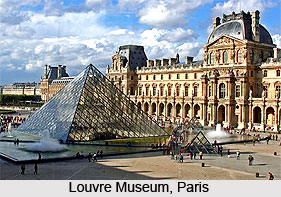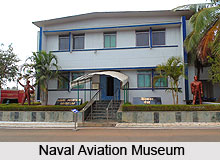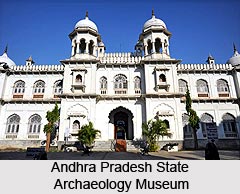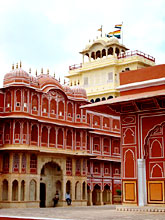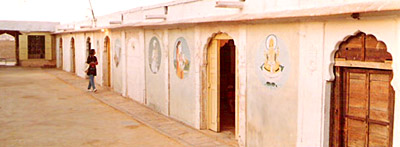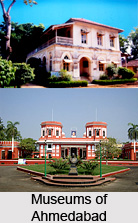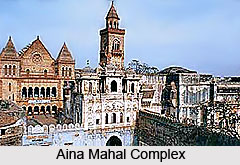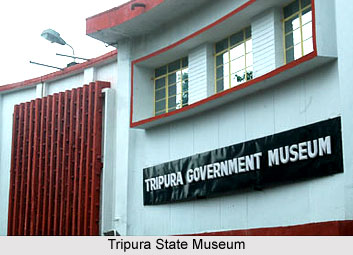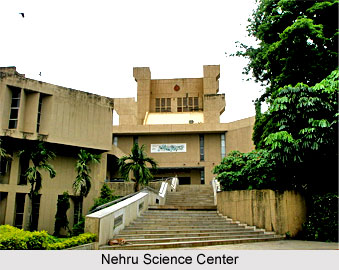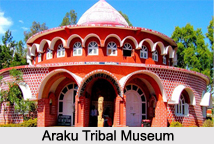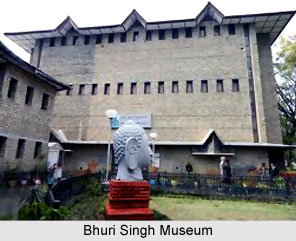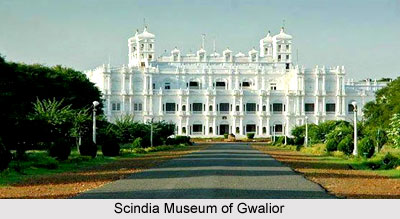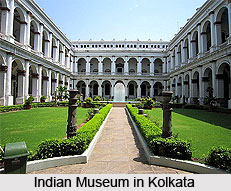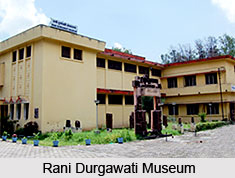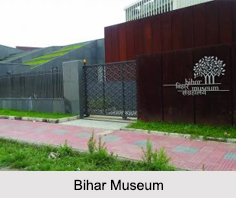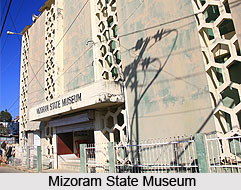Introduction
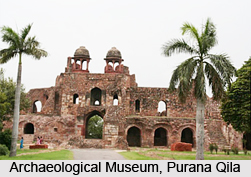 Indian Archaeological Museums are famous for providing a vivid picture of the Indian subcontinent. They play an integral role in preserving the rich cultural heritage of India, and are present in almost all the major Indian cities. Indian Archaeological Museums exhibit a large variety of excavated materials from ancient and medieval India. Apart from providing information and exhibiting important archaeological elements of ancient times, Indian Archaeological Museums also conduct archaeological excavations. The main objective behind this is to discover archaeological evidences of ancient India and unfolding the history of Indian civilization. Archaeological records like sculptures, portraits, coins and currency, revenue and court fee stamps, wooden and bronze sculptures, armory etc are ideally housed in the Indian Archaeological Museums.
Indian Archaeological Museums are famous for providing a vivid picture of the Indian subcontinent. They play an integral role in preserving the rich cultural heritage of India, and are present in almost all the major Indian cities. Indian Archaeological Museums exhibit a large variety of excavated materials from ancient and medieval India. Apart from providing information and exhibiting important archaeological elements of ancient times, Indian Archaeological Museums also conduct archaeological excavations. The main objective behind this is to discover archaeological evidences of ancient India and unfolding the history of Indian civilization. Archaeological records like sculptures, portraits, coins and currency, revenue and court fee stamps, wooden and bronze sculptures, armory etc are ideally housed in the Indian Archaeological Museums.
Some of the Indian archaeological museums restrict their concentration only on the archaeological heritage of the place, where they are situated. However, most of the museums concentrate on the entire archaeological heritage of India and they try to collect and exhibit the archaeological components. Among the numerous archaeological museums in India, there are only a few that have earned recognition not only in India, but also in the world.
Archaeological Museum at New Delhi
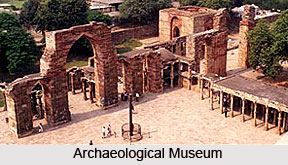 The Archaeological Museum, situated at Purana Qila, is present towards the right-hand direction of the gateway.
The Archaeological Museum, situated at Purana Qila, is present towards the right-hand direction of the gateway.
Excavation discoveries, including, items, pertaining to the Maurya, Sunga, Kushana, Rajput, and the Muslim dynasties, are considered as assets of the Archaeological Museum, Delhi. Excavations have unfolded the testimonies of most ancient settlements and lifestyles. Past traditions got depicted through painted grey ware and a cultural chronology, maintained from, Mauryan to the Mughal era. The renowned team of the Archaeological Survey of India, conducted intensive excavation-programme at the Purana Quila in 1955. They revived the enterprise, again, from, 1969 to 1973.
The excavators procured unearthed objects, such as, pottery, relics, coins, ornaments, seals, rock edicts, ruins of old building-structures and palaces, etc. The antique articles collected from various parts of Delhi, are also preserved in this Archaeological Museum, at Purana Qila, of New Delhi.
The visiting period is scheduled from 10a.m. to 5p.m. , except on Fridays.
The Archaeological Museum, at Purana Qila, introduces us to the rich tradition, that has transmitted by the past royalty of India.
Archaeological Museum at Badami
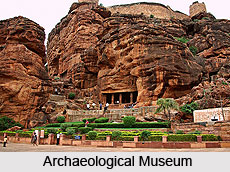 Ruled from 6th to 8th century AD by the early Chalukyas, Badami in the state of Karnataka was their capital. Its ancient name was Vatapi, Vatapiadhistana and Vadavi. Today, in the successive century, Badami is a place of unique tourist destination. The place is beautifully decorated with excavated rock caves of Brahmanical, Buddhist and Jaina affinity, massive sculptures, and structural temples of Dravida Vimana type.
Ruled from 6th to 8th century AD by the early Chalukyas, Badami in the state of Karnataka was their capital. Its ancient name was Vatapi, Vatapiadhistana and Vadavi. Today, in the successive century, Badami is a place of unique tourist destination. The place is beautifully decorated with excavated rock caves of Brahmanical, Buddhist and Jaina affinity, massive sculptures, and structural temples of Dravida Vimana type.
Near the famous Pallava Narasimhavarmman`s inscription in the northern hill, the Archaeological Museum was established. It was set up with an intention to store explored materials, sculptures, inscriptions, pre-historic stone implements, hero stones, etc. Later in 1982, it was transformed to a full-fledged museum.
The museum mainly comprises of four galleries, an open gallery in the veranda and an open-air gallery in the front. There are various sculptures of Shiva in different forms, Ganapati, forms of Vishnu, panel narrating Bhagavata scenes, Lajjagauri, etc. Apart from these, there is a scaled model of a nearby pre-historic rock shelter, the Shidlaphadi Cave, with various stone artifacts, pre-historic art and their activities. Objects that have been displayed in the open veranda and the open-air gallery include hero stones, inscriptions, carved architectural members and pair of impressive dwarapalaka figures on pedestals. Epigraphy and architecture have been organized in a new gallery.
The most interesting pieces include Lajja Gouri, Makara Torana, narrative panel depicting Bhagavata, animal figurines like lion, elephants, Kalarimurthy, Tripurantaka Siva and Bhairavi.
The museum is kept open from 10am to 5pm everyday except Fridays. It charges an entrance fee of Rs 2 per head. Children up to the age of 15 are free to enter.
Archaeological Museum at Cochin
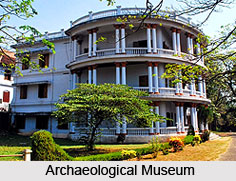 Kerala, meaning the `land of coconut` or `land of the Chera` is a typical state with a regal grandeur of its own. It has a majestic look for its natural beauty and eloquence.
In this beautiful state, is located the Archaeological Museum at Cochin. Known as the Cochin Hill Palace, this museum was transformed from a palace to a museum.
This museum has galleries of crafts, arts, paintings, weapons, old horse driven carriages, ornaments of royal use and a large variety of other items used by the rulers of Kerala. A protected room is used to with modern inspection equipments to exhibit the ornaments and jewelries of the kings.
Kerala, meaning the `land of coconut` or `land of the Chera` is a typical state with a regal grandeur of its own. It has a majestic look for its natural beauty and eloquence.
In this beautiful state, is located the Archaeological Museum at Cochin. Known as the Cochin Hill Palace, this museum was transformed from a palace to a museum.
This museum has galleries of crafts, arts, paintings, weapons, old horse driven carriages, ornaments of royal use and a large variety of other items used by the rulers of Kerala. A protected room is used to with modern inspection equipments to exhibit the ornaments and jewelries of the kings.
People visiting Kerala are sure to visit the place. The entry fee is not very high. It is only Rs 11 for adults and Rs 7 for children of 5-12years. Mobile phones and cameras are not allowed inside the museum. Ordinary still camera can be used outside campus. A charge of Rs 20 has to be paid for the still cameras and Rs 1500 for the video cameras.
In addition to these, shoes are also not allowed inside the main building. Shoes can be kept in a counter. There are parking fees too. Two wheeler vehicles fees is Rs 5 and that of the four wheelers like the buses and others is Rs 30.
The Archaeological Museum , Cochin welcomes people to visit in between 9am to 12:30pm and 2pm to 4:30pm. Again from 4:30 onwards till 6 o`clock in the evening, people are allowed only to enter the campus up to the children park. The museum remains closed on Mondays. Other than these, there is a canteen for the visitors to enjoy food and also a dear park and a children park.
Archaeological Museum at Lothal
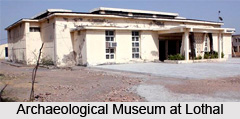 Archaeological museum is Lothal located in the Ahmedabad district of Gujarat. The museum was established in 1976 to preserve the material, which were excavated during 1950`s.The museum is divided into three galleries.
Archaeological museum is Lothal located in the Ahmedabad district of Gujarat. The museum was established in 1976 to preserve the material, which were excavated during 1950`s.The museum is divided into three galleries.
The first gallery exhibits a wonderful model of Harappan city of Lothal. The second gallery contains terracotta ornaments, replicas of seal and sealing, shell and ivory objects, copper and bronze objects, tools and potteries, beads, etc. The third gallery exhibits human figurines, weights, painted potteries, objects recovered from burials and ritual objects, miniature potteries, bricks etc. The museum also has its own library. The museum is open on all days from10 A.M. to 5 P.M except, Fridays.
Taj Museum, Taj Mahal
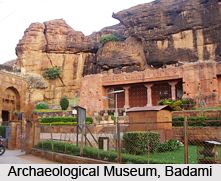 It is one of most famous archaeological museums of India in Agra district of Uttar Pradesh. It is situated within the Taj Mahal complex, more specifically, in the Jal Mahal. The three galleries of the museum exhibit artifacts related to the construction of Taj Mahal and the architects involved in building this magnificent structure. Manuscripts, paintings, specimen of calligraphy, government decrees, utensils, arms, marble pillars etc form the exclusive collection of this beautiful museum. The main hall of the museum houses the paintings of the Mughal emperor, Shah Jahan and his wife Mumtaz Mahal on ivory, encased within decorated wooden frames.
It is one of most famous archaeological museums of India in Agra district of Uttar Pradesh. It is situated within the Taj Mahal complex, more specifically, in the Jal Mahal. The three galleries of the museum exhibit artifacts related to the construction of Taj Mahal and the architects involved in building this magnificent structure. Manuscripts, paintings, specimen of calligraphy, government decrees, utensils, arms, marble pillars etc form the exclusive collection of this beautiful museum. The main hall of the museum houses the paintings of the Mughal emperor, Shah Jahan and his wife Mumtaz Mahal on ivory, encased within decorated wooden frames.
Archaeological Museum, Khajuraho
The Archaeological Museum in Khajuraho, Madhya Pradesh, was built in 1967. It displays the loose sculptures from the temples of Khajuraho. The most famous artifacts of this museum include sculptures of Jaina, Brahmanical and Buddhist faiths. The museums comprises of five galleries along with a massive hall.
Archaeological Museum, Sanchi
The Archaeological Museum in Sanchi, Madhya Pradesh, was initially built atop a hill by Sir John Marshall, former Director General of ASI in the year 1919. The museum displayed the collection of artifacts excavated in Sanchi. Later, owing to insufficiency of space, this museum was shifted to a collage building which was subsequently transferred to a new building in 1966. The museum has four galleries and a main hall. The artifacts of this museum are the representatives of Maurya, Satavahana, Sunga, Kushana and Gupta eras.
Archaeological Museum, Konark
This museum stands in the town of Konark in Puri district of Orissa. It hosts numerous loose sculptures and architectural specimens of the famous Sun temple. The present building of the museum was established in 1968, at a little distance from the main temple. The museum houses four grand galleries, where the first gallery has 62 artifacts, second one has 108 antiquities, third has 45 articles and the fourth one has 45 artifacts on display. The corridor of the museum holds pictures of archaeological sites and ancient monuments, which depicts the evolution of the architecture of Orissa.
Archaeological Museum, Vikramshila
This museum is situated in the ancient site of Vikramshila in the vicinity of the Bhagalpur district of Bihar. It was constructed in the year 2004 for displaying various artifacts excavated in course of time from this region. The building of the museum forms a cruciform shape. The ground floor of the museum has on display stone sculptures related to Buddhism such as Buddha, Avalokitesvara, Bodhisattvas, Loknath, Marichi etc and mythological figurines including Lord Shiva, Lord Ganesha, Parvati, Lord Krishna, Sudama etc. Objects of terracotta and iron are also displayed in this floor. The first floor hosts articles such as multi shaped beads, lockets, pendants, bronze images, shell objects and many other antiquities.
Archaeological Museum at Kamalapur, Kannada University
The Archaeological Museum at Kamalapur in the state of Karnataka is storage of historical objects.
Established in the year 1994, the Archaeological Museum at Kamalapur is exactly located in the Vidyaranya Campus of the Kannada University. It preserves the stone objects and tools, armouries, wooden objects etc.
The museum is kept open from 10am to 4:30pm. It remains closed only on University holidays.
Archaeological Museum at Kamalapur, Hampi
The Archaeological Museum at Kamalapur Post in the state of Karnataka is an important historical place. Established in the year 1954, this Archaeological Museum stores excavated materials of Karnataka, valuable sculptures, articles and many more.
Exactly located at Hampi, this Archaeological comprises of stone sculptures and architectural pieces of Vijayanagar Period, gold, miniature paintings, metal objects, crystal, ivory and semiprecious objects. Coins, palm leaf manuscripts, copper plates, paintings and copper coins enrich the collection.
The museum welcomes historians, scholars and general visitors to show its possessions from 10am to 5pm except on Friday.
Archaeological Museum of Aihole
Aihole, also known as Aryapura or Ayyavole (by the ancient times), is located in the Hungunda taluk of Bagalkot district of Karnataka. Aptly designated as the `cradle of Indian Architecture`, this village of Karnataka, once known as the cultural capital of the early Chalukyas of Badami (6th-8th century AD) is of great historical interest. The Archaeological Museum is located here in the Durga Temple Complex. In 1970, it was planned as a sculpture shed and later in 1987, it was converted into a full-blown museum.
The museum encompasses six galleries and an open-air gallery. Among these, two galleries have been reorganized in order to display the pre and proto historic material, epigraphy and architecture. Another gallery exhibits bird`s eye view model of Aihole and its hinterland. The displayed items comprises of the sculpture of Saiva, Sakta, Ganapatya, Vaishanva, Jaina and Buddhist affinity. In addition to these, there are also Hero stones, Sati stones, and inscribed slabs in the open-air gallery. Other exhibits include, stone sculptures of Brahmanical, Jaina and Buddhist faith, fragmentary carved architectural members, inscriptions, hero stones, sati stones etc. Apart from these items, there are also a variety of Ganesha sculptures, Saptamatrikas with archaic features, Nataraja, Ambika of Jaina affinity, attractive sculpture of Bodhisatva and a mutilated anthropomorphic figure of the Megalithic Period.
The visiting hour of the Archaeological Museum is from 10am to 5pm except on Friday.
Archaeological Museum of Vaishali
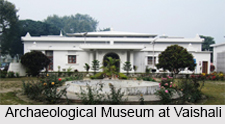 Archaeological Museum of Vaishali is one of the prominent tourist attractions in Bihar.
Vaishali has a rich cultural past .It is the birthplace of Lord Mahavira.
Archaeological Museum of Vaishali is one of the prominent tourist attractions in Bihar.
Vaishali has a rich cultural past .It is the birthplace of Lord Mahavira.
Location of Archaeological Museum of Vaishali
Archaeological Museum of Vaishali is located near Kharauna tank. The Government of India set up the museum in 1971.
Collections of Archaeological Museum of Vaishali
Archaeological Museum of Vaishali contains various types of terracotta, seals and sealing, beads of semi-precious stones, punch marked and cast coins, pins and styli of bone, antimony rods of copper, balls of stone, terracotta and ceramic specimens, which were either excavated or collected from the nearby places. There are four galleries in the museum.
Galleries of Archaeological Museum of Vaishali
The first gallery of Archaeological Museum of Vaishali contains moulded bricks and brick tiles terracotta elements of human figure, Naigamesha, mother and child, Durga, images of Bodhisattva, a female figure etc. Terracotta of ram, elephant, horse, bull, dog, monkey, birds, snake hood, seals and sealing, wheel, rattle, dabber, beads are preserved in the second gallery. The third gallery houses objects like bone, antler, arrowheads, bangle, iron and copper implements like knife, nail, bell, etc. The fourth has a huge collection of pottery objects including bowl, dish, miniature vessel, vase, lamp, inkpot, lid bell, sprinkler and spout etc. Archaeological Museum of Vaishali also houses potsherds of NBP and PGW which include bangles, arrowheads, bones etc. Other than these, the museum displays iron and copper instruments like knife, nail, bell etc in the third gallery. The museum is open on all days from 10 am to 17 pm except on Fridays.
Tourism with Archaeological Museum of Vaishali
The tourists and people who are interested in exploring the history of the region often visit this museum. Findings like human figurines, plaque of Buddha, Naigamesha, mother-child, Durga, Bodhisattva plaques are important for history writing and full exploration of Vaishali.
Visiting Information
Archaeological Museum of Vaishali is located in the main city of Vaishali, Bihar. The museum, closed on Friday, has hundreds of other antiques to show including the terracotta figurines of bull, dog, monkey, ram, elephant, horse, birds, snake hood, seals and sealing, wheel, rattle, dabber, beads, toilet pan of terracotta, copper punch marked and cast coins, etc.
Nalanda Archaeological Museum
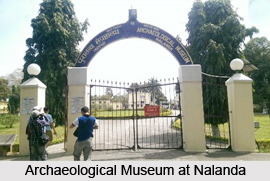 Nalanda Archaeological Museum is famous for the ancient Nalanda University, which was established in the 5th century B.C during Gupta period. Nalanda Archaeological Museum exhibits the antiquities that have been unearthed at Nalanda, Bihar as well as from nearby Rajgir. Out of 13,463 items, only 349 are on display in four galleries.
Nalanda Archaeological Museum is famous for the ancient Nalanda University, which was established in the 5th century B.C during Gupta period. Nalanda Archaeological Museum exhibits the antiquities that have been unearthed at Nalanda, Bihar as well as from nearby Rajgir. Out of 13,463 items, only 349 are on display in four galleries.
Establishment of Nalanda Archaeological Museum
Nalanda Archaeological Museum was established in the year 1917 with a view to preserve the precious elements, which were excavated at the premises of the famous monastic university and from Rajgir, Bihar.
Location of Nalanda Archaeological Museum
Nalanda Archaeological Museum is located near the ruins of the famous Nalanda Mahavira.
Collections of Nalanda Archaeological Museum
Nalanda Archaeological Museum has several galleries, which hold 13463 antiquities. The entrance hall exhibits sixteen sculptures including the sculptures of Trailokya Vijay, Bodhisattvas Avalokiteshvara, Maitreya, Gautama Buddha in Varad, Dharmachakra and Bhumisparsh posture, Samantbhadra, Parshvanath and Nagaraj. A big model of excavated remains of Nalanda University was also kept in this hall.
Gallery of Nalanda Archaeological Museum
The First gallery of Nalanda Archaeological Museum consists of fifty-seven images and sculptures including Khasarpana, Heruka, Marichi, Vagesvari, Vaishali-mircle, Buddha in varad mudra, miracle of Sravasti, Surya, Lakshmi, Ganesha, Shiva-Parvati, Kuber and Rishabhanath. The second gallery contains different types of elements like terracotta, stuccos, iron implements and inscriptions. Those of the terracotta seal with legend "Sri Nalanda Mahavihariya arya bhikshu sanghasya", the stone inscriptions of Yashovarmana, Purnavarman of Vipula Srimitra, fragmentary tablet of Nidanasutta, terracotta tiles showing swastika and kirtimukha, Dharmachakra, Votive Stupas in pipal leaf motiff, sample of charred rice and a multi spouted pot related to serpent worship are also housed here and are worth mentioning.
Third Gallery of Nalanda Archaeological Museum
In the third gallery the images related to Buddhist and Bramhanical religion were preserved .The images of Buddha in boon giving pose, Tara, Prajnaparmita, Loknath, Bodhisattava padmapani, Buddha in earth touching pose, Ganesh, Surya, Kamadeva, Indrani and Vishnu are kept in this gallery.
Sculptures Collected in Nalanda Archaeological Museum
There are thirty-six stone sculptures and images in the fourth gallery among which Kinnaras worshipping kalpadrum, Vishnu, crowned Buddha in preaching pose, Gautama Buddha in Bhumisparsh-mudhra, Marichi, Vajrapni and Padmapani Bodhisattvas are the significant ones. Two big jars excavated from the premises of Nalanda University are also preserved in the museum.
Timings of Nalanda Archaeological Museum
Nalanda Archaeological Museum is open on all days from 10.00 am to 5.00 pm leaving Fridays.
Archaeological Museum and Portrait Gallery at Goa
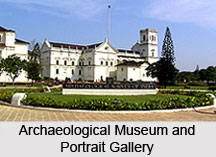 Archaeological museum and portrait gallery in Panaji, Old Goa was earlier a wing of the old Franciscan monastery. It was converted to a museum in 1964 by the Archaeological Survey of India. The museum exhibits a collection of pre-colonial and post colonial artefacts. Brahmanical sculptures, hero-stones and sati stones of the early and late medieval periods, portraits, coins and currency, revenue and court fee stamps, wooden and bronze sculptures and armoury of the Portuguese period. The main hall of the museum is flanked by a huge statue of Alfonso de Albuquerque in its entrance gate. The statue was earlier situated in Old Goa and subsequently at the Azad Maidan in Panaji. After liberation it was placed in the museum. The other areas of the museum consist of the `Key Gallery`, the `Portrait Gallery` and the `Sculpture Gallery.`
Archaeological museum and portrait gallery in Panaji, Old Goa was earlier a wing of the old Franciscan monastery. It was converted to a museum in 1964 by the Archaeological Survey of India. The museum exhibits a collection of pre-colonial and post colonial artefacts. Brahmanical sculptures, hero-stones and sati stones of the early and late medieval periods, portraits, coins and currency, revenue and court fee stamps, wooden and bronze sculptures and armoury of the Portuguese period. The main hall of the museum is flanked by a huge statue of Alfonso de Albuquerque in its entrance gate. The statue was earlier situated in Old Goa and subsequently at the Azad Maidan in Panaji. After liberation it was placed in the museum. The other areas of the museum consist of the `Key Gallery`, the `Portrait Gallery` and the `Sculpture Gallery.`
In 1962 the museum was reorganized completely. It brought a complete new look the museum. In the visitors lobby sea maps are displayed showing the sea routes of early explorers and site museums in India. The map of Goa and a few photographs of monuments of Goa and Daman are also exhibited.
The `Key Gallery` on the ground floor of the museum introduces a visitor to the short history of Goa in the form of an open book placed on a pedestal. The gallery also has its store among other things, a big statue of Luis Camoes, the famous Portuguese poet. The statue is seen holding a copy of `Os Lus¡adas.` This was also placed to the museum after the liberation. In the gallery a visitor also comes across a wall showcase containing middle and upper Paleolithic stone tools, Microliths and a few Neolithic Celts. In the second showcase the early history of Goa is projected. The excavated materials from Chandor, one of the ancient capital cities of goa have been displayed along with the ground plan of a Brahmanical temple. Early historical antiquities like the cast copper coins of 3rd century BC, copper nails, rings, etc. have also been preserved here.
The `Portrait Gallery` in the museum is situated on the first floor. It has over sixty paintings of the notable Portuguese Governors and Viceroys who ruled Goa. It contains portraits of the first- Dom Joao de Castro (1545-48) and other distinguished people like Dom Vasco da Gama (1524), the only Goan Governor, Bernardo Peres da Silva (1835) and the longest serving governor of Goa, Jose Ferreira de Pestano (1844-51 and 1864-70). It also There is also a portrait of Portugal`s right wing prime minister and dictator, Antonio Salazar.
The `Sculpture Gallery` in the museum holds some artefacts dating back to the pre-colonial era. The museum also has many ancient stone sculptures and idols to the Kadamba dynasty. A stone pillar brought from San Thome, Chennai and the site of martyrdom of St Thomas is also visible in the museum. Apart from these the sculptures of the Brahmanical deities and displayed in chronological order with the bust of Lord Shiva and Parvati, followed by the sculptures of the Silaharas and Kadambas of Goa.
Archaeological Museum Guntur
Situated at Macherla Mandal of the district Guntur in the state of Andhara Pradesh, the Nagarjunakonda Archaeological Museum is a place of interest for the historians, researchers and general visitors. Planned as a Buddhist Vihara, this museum is a better place for historians, researchers and general visitors.
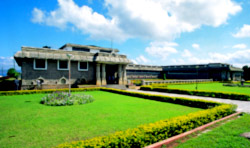
This museum exhibits items related to the Buddhist and Brahmanical faiths. As the name suggests, this museum was named after the Buddhist scholar and savant Acharya Nagarjuna. To preserve and display the antiquities collected from the excavations, this museum is a grand mansion in its own beauty. There are five galleries in the museum that exhibits different items of all cultural periods. This includes carved lime stone slabs, sculptures, inscriptions, and other antiquities of 3rd and 4th century A.D.
The main gallery exhibits the masterpieces of Ikshvaku art and architecture. This art and architecture has taken several forms as the all-pervading serene Buddha, well sculptured amidst the ayaka-slabs, the cross beams of ayaka platforms. There are also showcases all around the wall, which shows the development of human civilization from Stone Age to the Megalithic period through excavated artifacts and ample illustrations. The minor antiquities include terracotta and stucco figurines, seals and coins.
Apart from this, there are also two galleries located in a large hall, exhibiting the decorated drum slabs, dome slabs, cornice, beams and other architectural units of a stupa, a few Brahmanical sculptures, and a variety of earthen ware of the Ikshavaku and subsequent periods. The carved architectural units that once used to decorate the various stupas, confine the life of the Master from birth to Mahaparinirvana. It displays how the Master had to pass through the events of great departure, meditation, enlightenment and preaching. The carvings in the museum also portraits the Jatakas like the Sasa-jataka, Champeya-jataka, Sibi-jataka, Mandhathu-jataka, and several others. The other Brahmanical sculptures that are exhibited here include Kartikeya and his consort Devasena, a Sivalinga, Sati and a few figures of Vidyadharas. Other interesting items that have been displayed in the museum are the carved mandapa pillars depicting joyous moods of children at play, war themes and other secular themes, medallions showing elephants in majestic postures and the example of a drawing (hastalekha) on a slab. The artistic excellences of the potters are displayed here in the museum in polished, designed, utilitarian household articles.
The third gallery of the Nagarjunakonda Archaeological Museum abodes models of the submerged valley and also of secular and religious structures. The floor of the museum, on the other hand, exhibits the model of the valley with its topographical environs. Neolithic and Megalithic burials, stupas showing a variety of plan along with the Mahastupa, viharas like the Mahisasaka, Bahusrutiya, Kumaranandivihara, Brahmanical temples dedicated to Sarvadeva, kartikeya, Pushpabhadrasvamin, Ashtabhujasvamin, and lot more are exhibited in the showcases of the museum. There are also the models of the secular edifices such as the amphitheatre, bathing ghat, etc.
Among these galleries, one gallery represents select specimen of the epigraphs, decorated architectural members and medieval sculptures. There are also written inscriptions on the pillars that form the part of the structural complexes, sculptures, pedestals, memorial pillars and detached slabs. Mostly they are written in Prakrit language and some in Sanskrit also. The most notable inscriptions among all these are the inscriptions of Vijaya Satakarni, the memorial pillar depicting King Vasishthiputra Chamtamula, ayaka pillar of Chamta Sri, the Buddhapada, inscription and a Sanskrit inscription on a pillar invoking God Pushpabhadrasvamin. In addition to all these, there is also a Telegu inscription issued by king Purushottama of Orissa. The Medieval sculptures that have got its place in the museum include ornate Yoga-Narasimha, Mahishmardini, Durga, Siva and a Jaina Tirthankara seated in Yoga posture (14th-17th century AD).
People who are interested to visit historical places may visit the museum from 9am to 4 pm, except on Friday. The entrance fee is very cheap. It is Rs.2 per head. Moreover, children upto 15 years of age are free to enter the museum.
Archaeological Museum at Medak
The Archaeological Museum, Medak in Andhra Pradesh was established in the year 1952 . As the name suggests , Archaeological Museum, Medak, Andhra Pradesh is a storehouse of excavated materials such as terracotta figurines, beads, pottery, and coins of the Satavahana Period. It also consists of the Stone Age tools.
Interested people are likely to visit the museum on Kondarpur, via Sangareddy. The time for the visitors is 10:30a.m to 5:00p.m, except on Fridays.
Tulsi Archaeological Museum
Tulsi Archaeological Museum was set up in the year 1977.It is located at Ramvan, in Satna District of Madhya Pradesh.
The museum contains miscellaneous objects including stone elements, terracotta, copper coins, copper plates, gold silver metal sculptures, birch ark, and palm-leaf and paper manuscripts. The museum is open on all days from 10 a.m to 7 p.m except on Mondays and public holidays.
Hari Singh Gaur Archaeological Museum
Hari Singh Gaur Archaeological Museum is located inside the campus of University of Sagar, Madhya Pradesh.The museum is under the guidance of Department of Ancient Indian History, Culture And Archaeology of that University. It was established in the year 1958 to provide practical knowledge to the student of that department. The museum houses stone sculptures, coins, seals, inscriptions, beads, stone tools terracotta, potteries and many other objetcs.
The museum is open on all days from 7 A.M. to 1 P.M.during summer and from 10.30 A.M. to 4.30 P.M in winter leaving Sundays.
Archaeological Museum at Ropar
Archaeological Museum is located at Rupnagar in Punjab.Rupnagar is previously known as Ropar.It was established in the year 1998.This museums contains several archaeological elements of excavated Harappan site like antiquities of Harappan civilization.
It houses several other ancient elements like Painted Grey ware culture of 1000 BC; Northern Black Polished Ware Culture of 600 BC. It is the storehouse of various elements (steatite seal, copper and bronze implements, ring stone, yakshi image, gold coins) of Saka, Kushana and Gupta dynasties. The museum is open on all days from 10.00 am to 5.00 pm except Fridays.
Archaeological Museum at Bijapur
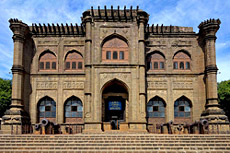 Bijapur, an important district in the state of Karnataka is well known for its great historical monuments built during the Adil Shahi dynasty. Earlier known as Vijayapura during the 10th-11th centuries by the Chalukyas of Kalyani, Bijapur got its name by the late 13th century.
Bijapur, an important district in the state of Karnataka is well known for its great historical monuments built during the Adil Shahi dynasty. Earlier known as Vijayapura during the 10th-11th centuries by the Chalukyas of Kalyani, Bijapur got its name by the late 13th century.
As a district of historical importance, Bijapur houses an Archaeological Museum. It was established in the year 1892 with an idea to preserve the antiquities of the period of Adil Shahi. Today it is a showhouse of Kannada Devangiri, Arabic and Persian inscriptions, stone sculptures and the armoury, porcelain, chinaware, coins, miniature paintings, manuscripts and carpets of Adil Shahi.
People who are interested to visit the museum may come between 10am to 5pm except on Fridays.
Archaeological Museum at Chandragiri
The history of Chandragiri, unfolds the legend that the Moon God performed atonement to please Lord Shiva here. Hence Chandragiri is the place of immense religious importance. Besides being an interesting Hindu pilgrimage center, Chandragiri is famous for its archaeological museum. This museum of Chandragiri in the midst of its archeological wonders and historical statues narrates the ancient history of different temples.
Established in the year 1988-`89, the Archaeological Museum was made within the Fort in the Raja Mahal. It is a storehouse of stone and metal sculptures and other cultural vestiges. It also houses a number of stone and metal sculptures of Saiva, Vaishnava, and Jaina kinship. There is also a relief of Rudra on its frontal facet.
Apart from all these, the Chandragiri Archaeological Museum contains a huge collection of the Bronzes of the late Cholas, Vijayanagara and Post Vijayanagara times like Umamahesvara, Vishnu as Venugopala Srinivasa, Kodandarama and the Devis like Sridevi, Bhudevi and Parvati.
Again, in the Durbar Hall Gallery of the Archaeological Museum of Chandragiri, the life size replicas of metal and stone statues of Vijayanagara rulers like Krishnadevaraya and his consorts-Chinnadevi and Tirumaladevi, Venkatapatiraya and Srirangaraya along with their respective queens are exhibited. Scaled models of the famous Parasuramesvara temple at Gudimallum are also exhibited.
The museum remains open from 10:00a.m to 5:00p.m except Friday. Interested people may visit the museum on time and relish the Indian culture.
District Archaeological Museum, Chhattisgarh
The District Archeological Museum is located in the Bastar district in the Indian state of Chhattisgarh. The museum ranks as one of the major tourist attractions in Chhattisgarh. It also serves as a major cultural site of the area. Bastar is one of the important districts in the state which has its headquarters at Jagdalpur. The district is popular for its idyllic scenery, historical sites and diverse tribal culture. Tourists visit the District Archeological Museum to get a glimpse of the rich tradition and culture of the place.
The District Archeological Museum in Chhattisgarh was established in the year 1988 by the state government. The museum was set up with a view to collecting the archaeological assets. The museum is credited with upholding and showcasing the diverse culture and rich tradition of the Bastar district. The museum has a huge collection of the interesting relics that have been found in the district. These are exhibited to the common people in a chronological manner. There are various sections in the museum which exhibit various relics ranging from the ancient times to the present ages.
The tribal section of the Archeological Museum also serves as an attraction to the visitors. Bastar is home to various tribal communities and the museum exhibits the rich tribal culture and traditions in the district. Bastar is a well known center for tribal folk culture. The tribal section in the museum depicts a variety of relics concerning the tribal lifestyle. There are a wide range of relics like tribal weapons, handicrafts, tribal farming instruments and other interesting items in the museum. The museum also displays remnants to make visitors understand and appreciate the origin and lifestyle of the tribal communities.
Various guided tours are organized by the tourist board and several travel agencies to the District Archeological Museum. Travelers who stay near the museum can also make walking tours there. Most tours start from the main city center of Jagdalpur. A very nominal fee is charged from the visitors to enter the museum. They are assisted by guides who provide useful information and interesting facts about the various relics in the museum.
Sri K.S.R. District Archaeological Museum
Established in the year 1992, Sri K.S.R. District Archaeological Museum, Anantpur has a cultural history. This museum was established in order to amass the archaeological elements of Anantpur and the allied areas.
Interested people can visit the museum to relish the historical sculptures, paintings, bidri ware, arms and weapons, bronzes, coins, stampages, copperplate epigraphs, stone, tool, celadon wares and enameled wares.
The museum can be visited during 10:30am to 5pm and remains close on Fridays and all public holidays.
District Archaeological Museum, Rewa, Madhya Pradesh
District Archaeological Museum is situated at Vyankar Bhawan in Rewa.It was established in the year 1989.The museum houses Stone objetcs, copper coins, paintings, stuffed animals, wooden furniture etc. The museum has its own library, which is enriched by valuable books in different subjects.
The museum is open on all days from 10.00A.M to 5.00 P.M leaving Mondays and public holidays.
District Archaeological Museum, Vidisha, Madhya Pradesh
District Archaeological Museum of Vidisha was established in the year 1964. The museums houses ancient sculptures, terracotta, coins plaster casts and earthen seals etc. The most prominent collections of this Vidisha museum are the images of yaksha and yakshi of 1st B.C and Surya and Chamunda figures.
The District Archaeological Museum, is open in all days from 10 a.m to 5 p.m leaving on Mondays and gazetted holidays.
District Archaeological Museum, Mahboobnagar, Andhra Pradesh
Located in Pillalamarry, Mahboobnagar, Andhra Pradesh, the District Archaeological Museum is a warehouse of archaeological artifacts, arts, sculptures and a lot more. Established in the year 1975, this museum provides the opportunity for the interested persons, general visitors, and others to view the Prehistoric artifacts, contemporary arts, miniature paintings, and manuscripts of Kakatiya Period.
Other exhibits include chinaware, coins, bronzes, arms and weapons, inscriptions on stone sculptures belonging to Eastern Chalukya, Western Chalukya and Rashtrakuta.
One who is interested can visit the place from 10:30am to 5pm except on Friday.
Archaeological Museum at Helibid
The Archaeological Museum at Helibid in the state of Karnataka was established in the year 1961. As such, a city with a historical background, this Archaeological Museum is a fascinating paradigm of historical elements.
It is a storehouse of wood and stone sculptures, idols, coins, copper inscriptions, palm leaf manuscripts, miniatures and bronze.
People who are likely to visit the museum may come between 10am to 5pm on all days except Friday.
Archaeological Museum at Hoshiarpur
Punjab has a rich cultural past. This state has contributed a lot in the field of art and artisans.
An Archaeological Museum was founded at Hoshiarpur in the year 1971 to preserve the archaeological elements of the state. The Museum houses Sculptures from Dholbaha, archaeological findings from Sanghol, Paleolithic tools from Hoshiarpur and several manuscripts. Archaeological Museum, Hoshiarpur is open on all days from 9 A.M. TO 5 P.M. except Saturdays and Sundays.
Pazhassi Raja Aarchaeological Museum
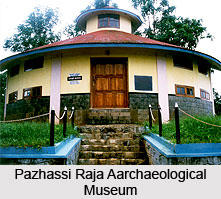 Kerala, with an exuberant green striped all over, is a place of historical interest. Having a history of its own, Kerala is also the house of several museums.
Kerala, with an exuberant green striped all over, is a place of historical interest. Having a history of its own, Kerala is also the house of several museums.
Relating to this, the Pazhassi Raja Aarchaeological Museum at Calicut in the state of Kerala is a grand museum for its variety of collections. It is a storehouse of pottery (burial) of the Neolithic Age, temple models and coins. It also displays the archaeological icons.
People who are interested to visit the museum may come between 10am to 1pm and 2pm to 5pm. It remains close on Mondays and Government Holidays.
District Archaeological Museum, Warangal, Andhra Pradesh
Established in the year 1991, the District Archaeological Museum, is located in the state of Andhra Pradesh. The museum is a show house of a wide range of archaeological artifacts. These also include pre historic antiquities, sculptures, palm leaf manuscripts, arms and weapons.
In addition to these, fossils, early historic antiquities, coins, Bidriware, terracotta, stuccos, chinaware, and enamelware are to be found. For the artists, the District Archaeological Museum, Warangal has in its core, the paintings, miniature paintings and sculptures. There are also epigraphs, copper plates, grants and bronzes.
The historians and the book lovers will more enjoy the library of the museum because it is well stocked and well maintained. Except Fridays and public holidays, the District Archaeological Museum of Warangal is open from 10:30am to 5pm for people to visit. The Warangal Junction Railway Station is the nearest railhead.
Archaeological Museum at Thrissur
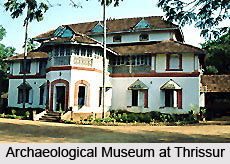 Kerala, with its scenic beauty and peaceful atmosphere attracts the tourist most. It is no less popular than the other tourist places of India. Here, in this abundance of natural beauty, the Archaeological Museum at Thrissur is another place of interest for historians, scholars and general visitors.
Kerala, with its scenic beauty and peaceful atmosphere attracts the tourist most. It is no less popular than the other tourist places of India. Here, in this abundance of natural beauty, the Archaeological Museum at Thrissur is another place of interest for historians, scholars and general visitors.
Established in the year of Independence, 1947, the museum is a wonder for its archaeological storage. It is exactly located in the Town Hall Road. It is generally famous all over India for its collection of murals and relics from the whole of Kerala. There are also life-size statues of the renowned personalities of the past. In addition to all these there are also pottery wares, beads, iron implements, stone implements, wooden models of temples, Indus Valley specimens, stucco head of Gandhara art, plastic models of sculptures through the ages, churches, Ajanta and Bagh caves, few bronzes and a few collection of coins.
The museum remains open from 8am to 5pm except on Mondays, Independence Day, Republic Day, Thiru Onam and Gandhi Jayanti.
Archaeological Museum at Bodhgaya
Bodhgaya is located in the district of Gaya, Bihar. Bodhgaya is the most sacred place for Buddhist religion. The Archeological museum of Bodhgaya was set up in 1956 to preserve the sculptures and valuable antiques of the area. The museum is divided into two galleries.
These two galleries mainly display bronze and stone sculptures of Buddhist and Brahmanical faith of Pala period, scenes related to Buddhist pantheon, Surya, Zodiac signs on railings of Sunga age, etc. Sculptures of standing Yakshi figure having elaborate coiffure, crowned Buddha in Bhumisparsamudra, Maiterya, images of Buddha in different attitude, standing image of Manjusri, terracotta plaque depicting Buddha in Bhumisparshmudra, railing pillar depicting Surya, panel showing Sahasra Buddha, copper antimony rod, miniature pot are preserved in the first gallery.
The second gallery displays the sculptures of Sapta matrika, Dikpalas, Dasavatara of Lord Vishnu. The open courtyard of the museum consists of railing pillars, cross bars and copingstones. There are two long verandahs in the museum, which exhibit a big image of standing Buddha in abhayamudra, varaha incarnation of Lord Vishnu, etc. The Museum is open on all days from 10.00 am to 5.00 Pm except Friday.
State Archaeological Museum at Kolkata
With several other factors making Kolkata a bright city in the whole of India, the cultural, art, sculpture, architecture and archaeology of Kolkata are also striking features of the city creating a difference in its own.
Built in 1962, the State Archaeological Museum of Kolkata houses the rare tools of the Early, Middle and the Late Stone Ages from Susunia (Bankura) and several other sites. Antiquities of proto-historic times from Pandu Rajar Dhibi (Burdwan), terracottas, sculptures, stone and stucco from the Gupta Maurya, Sunga, Kushana and Pala and Medieval times are stored in the State Archaeological Museum of Kolkata. In 1963 a new section was opened under the name of Historical Art to preserve the old terracottas, bronzes, woodcarvings, textiles and manuscripts.
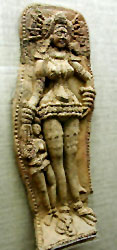 Apart from this, the gallery also sells several card sets and other publications. The main activities include explorations and excavations of historical sites. Moreover, the State Archaeology Department has found 350 odd pieces of terracotta statues dating back to the era of Buddha from Ramjibanpur. The Department will build three display galleries for these statues. It will be constructed in the annex building of the State Archaeological Museum in Behala. After the completion of the building by next year the museum will be shifted to the new building. 80 percent of the cost will be borne by the Museum Department while the other 20 percent will be dealt by the state. Among these three galleries, two galleries will be used to display paintings of the eminent artists of the 18th and 19th century. In addition to this the State Archaeological Department has also planned to build a gallery to display the boats of Bengal through virtual reality and with the three-dimensional effect.
Apart from this, the gallery also sells several card sets and other publications. The main activities include explorations and excavations of historical sites. Moreover, the State Archaeology Department has found 350 odd pieces of terracotta statues dating back to the era of Buddha from Ramjibanpur. The Department will build three display galleries for these statues. It will be constructed in the annex building of the State Archaeological Museum in Behala. After the completion of the building by next year the museum will be shifted to the new building. 80 percent of the cost will be borne by the Museum Department while the other 20 percent will be dealt by the state. Among these three galleries, two galleries will be used to display paintings of the eminent artists of the 18th and 19th century. In addition to this the State Archaeological Department has also planned to build a gallery to display the boats of Bengal through virtual reality and with the three-dimensional effect.
Laced with the Indian heritage and ethnicity State Archaeological Museum, Kolkata therefore stands as an insignia of India`s cultural and archaeological wonders.
Archaeological Museum at Amravati
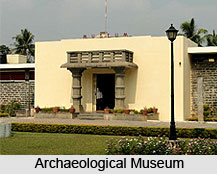 Located in the bank of river Krishna, Amravati is a small town and a center of pilgrimage in the Guntur district of Andhra Pradesh. Being a center of pilgrimage this town holds an Archaeological Museum depicting the history of Amravati itself.
Located in the bank of river Krishna, Amravati is a small town and a center of pilgrimage in the Guntur district of Andhra Pradesh. Being a center of pilgrimage this town holds an Archaeological Museum depicting the history of Amravati itself.
There are three galleries in this museum representing the different traditions, cultures, and explorations of Amravati. In the first gallery, which is also known as the key gallery,the art traditions of Amravati are displayed. Amidst the lotus and the purnakumbha, the two drum slabs, Buddha is represented symbolically in the form of `Svastika` in vajrasana and agni skanda (in another case). The structure of the standing Buddha that dates back to the 8th century AD has offered a distinct aura to the museum.
Sculptures of the 2nd century BC, an Yakshi of Bharhut tradition, a fragmentary pillar edict of Asoka Images of Buddha from Alluru, Dharma Chakra from Lingaraja Palli, Bodhistvas, a dome slab depicting the jewels of the Buddhist order are ideally housed in this Archaeological Museum of Amravati The full size ornate bull (nandisvara) of the Satavahana period is a work that demands appreciation. There are also other artworks such as the garland and bearer of a copingstone, the images of Vajrayana period, and a Jaina Tirthankara of Medieval times are full of vigor and vitality.
Other memorable and notable pieces of art that are preserved in this Archaeological Museum of Amravati depicts Gautama Siddhartha`s departure from his palace, return of the horse Kanthaka, episode of Nalagiri, the royal elephant of Ajatshatru, worship of Buddha`s feet by the lady worshippers, earlier forms of Ganesa and Ganesani among the Yakshaganas, Lakshmi in earlier period, and the panel showing divisions of the relics of Lord Buddha worth to be mentioned.
Interested people may visit the museum from 10a.m to 5p.m except on Friday. The entrance fee is Rs. 2 per head. Children upto 15 years of age are free to enter the museum.
Archaeological Museum at Delhi
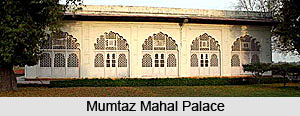 Archaeological Museum of Delhi, located in the Mumtaz Mahal (palace dedicated to Shah Jahan`s much-loved, wife, Mumtaz Mahal ) of the Red Fort, preserves the golden tradition and the magnificence of Mughal regime, that India was bestowed with.
Archaeological Museum of Delhi, located in the Mumtaz Mahal (palace dedicated to Shah Jahan`s much-loved, wife, Mumtaz Mahal ) of the Red Fort, preserves the golden tradition and the magnificence of Mughal regime, that India was bestowed with.
The Archaeological Museum, has housed, exclusive antiquity, belonging to the Mughal rule, and has treasured precious manuscripts, highlighting on the literary power and penmanship of ancient India.
In 1911, the Archaeological Museum was designed with the mission to gather all significant articles that cast around Delhi, the halo of historical importance. Or in other word, things which can make one relive the splendor of the past , through a view of them.
Among the wide spectrum of antiquarian products, exhibited in the Museum, arts, calligraphic assignments, dresses and accessories, maps, manuscripts, decrees or firmans and weapons, of Mughal period, deserve mention.
The Archaeological Museum, Delhi, consists of different departments. For instance, one department , is devoted to the 2nd and 3rd century artistic venture.
Again, there is a distinct compartment for the Indus Valley Civilization.
One must know, that one such segment, of Archaeological Museum, Delhi, has been offered to the reminiscence-kindling objects of the Mughal Emperor, Bahadur Shah Zafar. It incorporates, the resplendent pearl-embroidered silk drapery and a silver hookah, used by the eminent Emperor.
The collection, namely maps and weapons, related to the resurging Revolt of 1857, during British Raj, have found a place of prominence in this Museum.
Swords of various patterns , hookahs, chess sets, textiles with ornate embroidery , gorgeous blue tiles, beautiful paintings and so on, happen to be the hallmark of Archaeological Museum, Delhi.
The Archaeological Museum, Delhi, is the right site for workshops and seminars, organized for the spread of historical knowledge among the tourists, arriving in the city of Delhi . The visiting schedule for everyday was 10 am to 5 pm, leaving Fridays and the government holidays.
The Archaeological Museum, Delhi will continue to enchant visitors with its historical aura.
